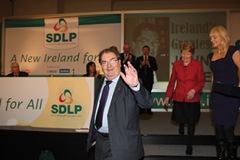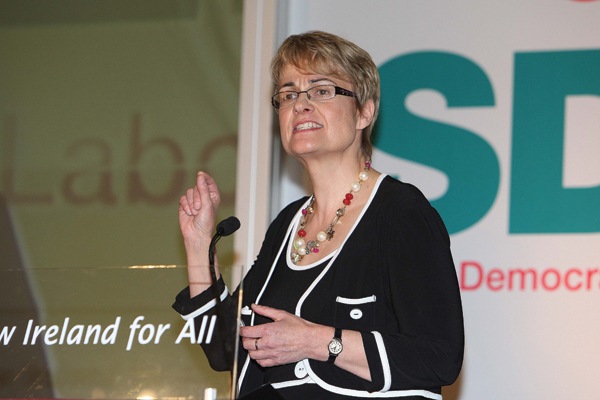SDLP conference: turning point?
Following the Westminster election, SDLP conference delegates were confident that the party’s long decline was over, but the real tests come next May against rivals Sinn Féin. Peter Cheney reports.
“We’ve bottomed out and we’re well on the way up again,” a councillor assuredly told some of the 500 delegates gathering for the second SDLP conference in a year. The first, in February, saw Margaret Ritchie elected leader and the party seemed to approach this one with a sense of post-election relief.
The Westminster campaign saw its three seats held and its support holding up. Two fresh electoral challenges await on 5 May, for Stormont and council seats. Margaret Ritchie’s first full conference as party leader also provided the occasion for presenting John Hume with his Ireland’s Greatest award from RTÉ.
Ritchie’s address began with tributes to past leaders and praise for the election campaign. The “stunning result” in South Belfast, though, seems over-hyped. The total unionist poll came to 14,010 to 14,026 for McDonnell, and some of Alex Maskey’s 4,000 supporters probably lent him their backing.
The substance of her speech was on the SDLP’s future direction and on emphasising its differences from Sinn Féin.
An all-island political alliance, much discussed in recent years, was only a long-term possibility. Any merger with a major southern party would effectively end the SDLP and its “unique brand values” would disappear. The party and those parties were, though, part of the same political family.
A single northern nationalist party, briefly suggested by Declan O’Loan, was also ruled out. There was still a “world of difference” between the SDLP and Sinn Féin “and how can we enter any tribal or sectarian pacts that would simply undermine everything we stand for?” O’Loan was not singled out for criticism and indeed got a mention later on, for preparing an economic policy.
Her party were “progressive nationalists”, she stated, claiming that Sinn Féin was “stuck in the past”, economically “suspicious of investors and entrepreneurs”. A shared future, in her view, meant accepting Ireland’s shared military history, including thousands of nationalists fighting in two world wars.
 Irish unity, Ritchie added, would not just arrive in 2016 and she claimed the SDLP would come up with credible answers to unionists’ questions. The two governments were also criticised for favouring the DUP and Sinn Féin. The Assembly’s survival since 2007 was its “only credit” and she predicted that a more centrist Executive would resolve the education and local government disputes.
Irish unity, Ritchie added, would not just arrive in 2016 and she claimed the SDLP would come up with credible answers to unionists’ questions. The two governments were also criticised for favouring the DUP and Sinn Féin. The Assembly’s survival since 2007 was its “only credit” and she predicted that a more centrist Executive would resolve the education and local government disputes.
As well as condemning the dissidents, Ritchie wanted Sinn Féin to “admit that what is wrong now was always wrong.” SDLP ideas, she complained, were being copied by Sinn Féin and the DUP in “magpie economics.”
Looking ahead, she predicted three SDLP MLAs returned in her own constituency. No specific targets were set but the speech rounded off with a rallying call for younger members and a drive to “reach the next horizon”.
The schedule included panel discussions, followed by questions, on the party’s three key themes: the economy, a shared society and Irish unity. Former MLA Sean Farren’s party history attracted a steady stream of curious readers.
Fearghal McKinney was meanwhile elected as one of two vice-chairmen. His election, simply to an internal post, was accompanied by an official press release which no doubt had an eye on next May. The chairman, for the record, is Joe Byrne.
One party member told agendaNi that there was a “real buzz” about the conference and the invited panels were an improvement, allowing members to hear and challenge different views. The traditional model of proposing and voting on motions had resulted in people “drifting off” to the bar, he remarked. Two observers said they had found the event rather quiet compared to, say, a UUP conference.
There was no groundswell of enthusiasm for the forthcoming election. Four SDLP seats are at risk due to boundary changes and the prospect of First Minister Martin McGuinness could galvanise Sinn Féin in favour, and a unionist pact in opposition.
Assemblyman PJ Bradley’s first impression was an event “coming down” with young people, which he welcomed. At the February conference, everything had centred round the leadership vote.
Ritchie’s speech, he commented, “went down very well” and it seemed she was “trying to cover all elements within the party” by referring to Fianna Fáil, Fine Gael and the Irish Labour Party. As for John Hume, Bradley noted: “Even 10 or 12 years after retirement, he’s still the big hero.”
Unity referendum expected
“It won’t be long before parties start calling for a referendum,” Mark Durkan remarked as he opened the Irish unity debate. He wanted to see a consensus among constitutional nationalists on what unity would mean in practice, which would be a clear alternative to republican dissidents. Fianna Fáil’s Mary Hanafin said unity needed to cover four strands: community, political, economic and sport. As the Republic’s Culture Minister, she already promoted the island as one tourist destination and backed its rugby team. Brian Hayes, for Fine Gael, was more direct, claiming that the Republic’s politicians had given “lip service” to unity. Partition was a “betrayal” of two minorities – northern nationalists and southern unionists – and the idea of Britishness in a united Ireland required debate. Labour TD Joanne Tuffy, who was born in England, sensed that the economy was a much higher priority for most southern voters. Irish Times columnist David Adams concurred and added that people needed to be allowed to be Irish in their own way.






